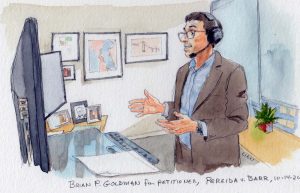Argument analysis: Justices weigh mandatory deportations based on “thin reed” of minor crimes

on Oct 19, 2020 at 10:05 am

On Wednesday, the Supreme Court heard oral argument in Pereida v. Barr, an effort by Clemente Pereida, who has lived in the United States without authorization for nearly 25 years, to avoid mandatory deportation by presenting evidence to an immigration judge that his deportation would cause exceptional and extremely unusual hardship to his United States citizen son. He was denied the opportunity to present this evidence because the Board of Immigration Appeals, and later the U.S. Court of Appeals for the 8th Circuit, found that a 2009 misdemeanor conviction disqualified him from a process known as cancellation of removal, even though it was unclear from his criminal records whether the misdemeanor actually constituted a disqualifying offense under federal law.

Brian P. Goldman phones in to argue for Clemente Pereida (Art Lien)
Section 240A(b)(1)(C) of the Immigration and Nationality Act precludes cancellation of removal for noncitizens “convicted” of a crime involving “moral turpitude.” Congress also provided in section 240(c)(4) that the noncitizen bears the burden of proving that he “satisfies the applicable eligibility requirements” for cancellation of removal. Pereida was convicted of attempting to commit a Nebraska crime labeled “criminal impersonation” after he used a false Social Security card to obtain employment. He was fined $100 and sentenced to no jail time. The Nebraska “criminal impersonation” statute contains several subsections, some of which constitute crimes of moral turpitude and some of which do not. In Pereida’s case, the court records merely recite each subsection of the statute without specifying which subsection Pereida was convicted of. That ambiguity brought his case to the Supreme Court.
Justice Brett Kavanaugh succinctly framed the central question for the court: “There’s a situation of uncertainty, and what that means is either some people who should not be eligible for cancellation of removal will remain in the country, or some people who should be at least eligible for cancellation of removal will be removed from the country.” On this point, it appears that a majority of the justices are reluctant to rule that noncitizens convicted of minor crimes, whose state court conviction records are ambiguous, face mandatory deportation. How they get there is another matter.
Much of the oral argument focused on the significance of the burden-of-proof statute. Chief Justice John Roberts began by suggesting that when the government bears the burden, it “has to carry the burden of looking to the least” of the elements necessary for conviction, but when a noncitizen bears the burden, he must show that the most severe offense on which his conviction could be based is not a disqualifying one. “Why isn’t it simply the different burdens under [federal sentencing statutes] and the immigration statute,” he asked, “that account for … the different burden?” Brian Goldman, counsel for Pereida, responded that the government actually agreed that this is not the rule: If Pereida’s conviction records had clearly shown the version of the crime for which he was convicted, the immigration court would look to the least of the acts necessary for a conviction of that version, regardless of the burden of proof. It is only when the conviction records are ambiguous that the government argues the burden-of-proof statute comes into play. Justice Sonia Sotomayor confirmed that all available conviction records had been produced and asked, “Doesn’t that answer the question of whether you’ve met your burden of proof?”
Justice Samuel Alito pursued a different angle, asking why determining the version of the offense is not “a question of fact” that is therefore subject to the burden of proof. Gorsuch and Justice Clarence Thomas appeared to agree. This was the principal argument pursued by the United States, represented by Assistant to the Solicitor General Jonathan Bond. Bond argued that Congress has decided how to allocate the burden of proof and thus who benefits and who loses depending on the context. In support, he pointed to legislation enacted in 1996 and 2005 that created the burden-of-proof statutes and limited the circumstances in which relief from removal could be granted.
Justice Stephen Breyer appeared unconvinced, stating that “there is a virtue in simplicity in the law” and that the simple thing to do is “keep[] the law uniform,” meaning that if Pereida has shown through his conviction documents that he was not necessarily convicted of a disqualifying crime, then he’s met his burden of proof. Sotomayor similarly suggested that, if the underlying state statute covers both disqualifying and non-disqualifying crimes, the court’s case law dictates that the “ambiguity flows … automatically” to the immigrant’s benefit.
Turning to the other federal statute at issue, Breyer, Sotomayor and Justice Elena Kagan emphasized the historical interpretation of the statutory term “conviction.” Kagan asked whether the burden-of-proof statute comes into play at all if determining the version of an offense is treated as a legal question, not a question of fact: “[A] lot of the questions that you’ve been getting would disappear if it were legal,” Kagan said to Goldman, “because even the government concedes, I believe, that questions of law are not affected by the burden of proof.” Goldman emphasized in response that the question of whether a conviction necessarily establishes every element of a federal offense (here a crime involving moral turpitude) is a legal analysis. The only reason to look at conviction records is “in service of the bottom-line legal question,” he said – or, in other words, “as a stand-in for the statutory text itself.” Thus, according to Goldman, if the conviction records “turn[] up empty,” the court should use an approach known as the categorical approach, which “supplies its own rule” and looks to the least severe of the alternative elements as the basis for comparison. Goldman pointed to 106 years of history, outlined in an amicus brief submitted by legal scholars, in which courts employed the categorical approach regardless of the burden of proof. In response to Bond’s argument that this is a factual question, Kagan replied that “every court in America treats” the analysis as a question of law.
A number of justices raised concerns about the practical problems that would arise from the government’s proposed rule of imposing the burden on immigrants to prove to an immigration judge that they were not convicted of a disqualifying offense. As Roberts stated, a noncitizen “can know what documents to look for, but the reality, as I understand it, is that often you don’t have [the details in the conviction records needed] because you’ve got a lot of … busy criminal dockets and plea bargains.” Bond agreed that conviction records for low-level misdemeanors could often be ambiguous given the high volumes facing local criminal courts.
Gorsuch suggested a solution. Though in Moncrieffe v. Holder the court rejected mini-trials to determine the nature of past offenses, Gorsuch suggested that this rule might not apply here, and asked Goldman whether Pereida could simply show through the facts and testimony that he “wasn’t using the Social Security card to obtain benefits or defraud anybody of anything but simply to get a job, and therefore, it wasn’t a crime of moral turpitude.” Thomas and Alito appeared sympathetic to this approach as well. Bond conceded, however, that the admissibility of evidence outside the record of conviction was not a live issue in this case.
Goldman further explained that examination of underlying facts would disserve the entire immigration court system by reopening past convictions to re-litigation in an administrative court. Here, an amicus brief on behalf of former immigration judges and members of the Board of Immigration Appeals described the complexity and inefficiency the government’s approach would wreak on deportation proceedings. Additionally, they and other amici explain that this approach would mean that the same conviction could lead to mandatory deportation in some cases and relief in others, depending on the witnesses and court records available. Goldman argued that the government’s rule would likewise apply to old convictions, such as a case involving a 1985 marijuana conviction on hold at the Supreme Court pending the outcome in Pereida’s case. In these situations, witnesses and evidence proving the nature of the offense would be difficult, if not impossible, to secure.
Finally, Kagan and Justice Brett Kavanaugh clarified that even if the court ruled in favor of Pereida, the attorney general could still deny relief. Both Goldman and Bond agreed that an immigration judge could deny relief if she believed that Pereida’s offense was a serious one, or the attorney general could use regulations to impose certain limits on immigration judges’ exercise of discretion. Goldman emphasized that this case is about a gatekeeping step. Any concerns regarding the underlying offense, he said, could be resolved at the discretionary stage. Kavanaugh responded, “That’s a fair point.”
A majority of the justices seemed resistant to making someone categorically ineligible for cancellation of removal based on, as Kavanaugh put it, such a “thin reed” when the criminal records are likely to be “thin as well.” If the court indeed rules this way, the case would follow the Supreme Court’s other decisions that have rejected mandatory deportation for drug paraphernalia in the form of a sock, the social sharing of a small amount of marijuana, and misdemeanor possession of a tablet of Xanax. What remains to be seen is whether applicants for deportation relief and immigration courts will have to relitigate past crimes as a result.


